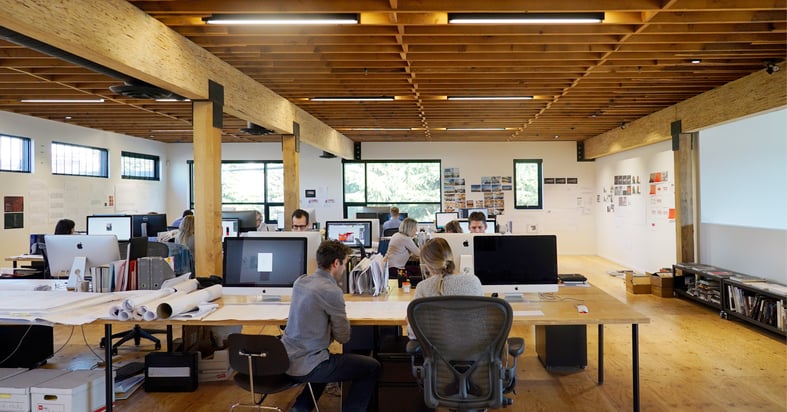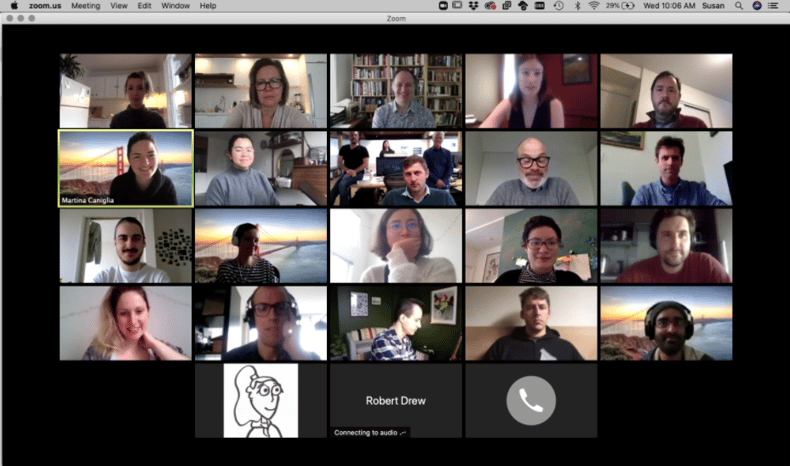Looking to keep fixed-fee projects on track?
Try Harvest free
Founded in 2008, PUBLIC: Architecture + Communication had a clearly defined mission from the very start. “My partners and I started our practice with the ambition of working in the public realm, hence the name,” explains Founding Principal, John Wall. “It’s the place that we all go when we're outside of our homes. So, whether it's the university or your local park, these are the spaces where we meet and make friends.”
Why Harvest?
Too often, they found, these critical spaces weren’t living up to the needs of the people who depend on them. “Public architecture can be good or mediocre,” he says. “It can help make spaces that people love to gather in, or spaces that are bleak and uninspiring.” What John and his team are trying to do is create more of the former. “We’re trying to create spaces that help tell a story about the community,” he says.
Examples of these kinds of spaces include transit shelters that make use of innovative wood construction—demonstrating a university’s environmentalism and forward-thinking attitude—and a barn-shaped soccer fieldhouse that gives a nod to a community’s agricultural roots.
In order to be able to tell such compelling stories on a tight, public sector budget, PUBLIC needs to keep a close eye on their project spend. They tried a few time tracking solutions, but nothing really caught on with their team. That is, until they discovered Harvest.
Losing track of time
“Most of our projects are billed on a fixed-fee basis—we don't bill hourly very often,” explains John. “So we try to manage how much time our team is putting into a project versus our fixed fee.” That leaves the team very little room for design exploration: If a project starts to creep outside of its intended scope, their public sector clients still expect them to deliver for the agreed-on price. Understanding how much their time is costing them is essential to remaining profitable.
From the perspective of a project leader, it doesn't take hours to generate reports—you can get the information you need in minutes.
To that end, PUBLIC struggled to find a time tracking solution that worked for them. Like many teams, they started by logging their hours in an Excel spreadsheet—but it wasn’t a good long-term solution. Then, they tried out a few different software products, but they didn’t go over well with the team. “The software we were using was pretty user-unfriendly,” says John. “The staff hated it.”
So, they kept looking—and eventually came across Harvest. The difference was night and day: “It’s definitely more intuitive,” says John. “We got much better uptake on it as a product.” On the reporting side, it was also more clear and easy to use. “From the perspective of a project leader, it doesn't take hours to generate reports—you can get the information you need in minutes,” he says. In a business where every dollar counts, that’s a critical advantage.
Managing time on a fixed-fee budget
One of the most important roles Harvest serves is keeping the team’s fixed-fee projects on track. “We’re forced into managing our time well,” explains John. “Going back to the client and saying, ‘You know, we budgeted X, we're not going to be able to deliver what you're requesting, and we need to consider additional services,’ is a very uncomfortable conversation. A lot of times clients will turn around and say, ‘No, that was your bid, you have to deliver.”
What's good about Harvest is you can get a trajectory of where you're going—day by day, week by week, month by month.
Harvest allows PUBLIC to keep a close eye on their progress, so they can avoid getting into that situation in the first place. “What's good about Harvest is you can get a trajectory of where you're going—day by day, week by week, month by month,” says John. “It gives our managers the tools to make sure a project stays on schedule and on budget.”
And, if they do notice a project getting off track, it gives them the opportunity to adjust. “If we start to exceed our budgeted hours, we have to make some decisions streamlining the work,” says John. “If we budgeted 70 hours on a task and end up spending 100, we need to figure out what we can do more efficiently.”
Pricing projects and staying profitable
Another area where Harvest has helped the PUBLIC team become more efficient is pricing. “Architectural billing is like folklore,” says John. “I learned about billing and project phasing from the architects I worked for, and they probably learned it from the architects they worked for. It was really just based around crude assumptions about how much time you should put into a project.” Harvest allows the PUBLIC team to move beyond the “folklore” of the past and make decisions based on real data.

Pricing a project is always a delicate balance in the public sphere. “When a proposal call comes out from a public client, there will be 10 or 20 architects bidding,” says John. “Our fee has to be competitive to get the job.” Harvest provides a backlog of their past work, allowing the team to understand not only how much time they spent on past projects, but also where they made—and lost—money. “It’s important to learn as you go, and Harvest is one of the tools that helps us do that,” says John. “It gives us feedback on how we’re doing so we can be competitive, make a profit, and keep ourselves afloat.”
While they can’t always use this information to increase their pricing (lest they lose the bid), it does reveal something just as important: When to walk away. “What Harvest helps us do is make decisions about not pursuing certain projects, because we know we can't be competitive,” says John. “It helps us spend our energy more wisely.” That way, they focus their attention on the projects that can make the biggest impact for their business.
It’s important to learn as you go, and Harvest is one of the tools that helps us do that. It gives us feedback on how we’re doing so we can be competitive, make a profit, and keep ourselves afloat.
In the past, PUBLIC would sometimes take on creatively interesting yet unprofitable projects, but as a more established firm, they’ve tried to break that habit. “After ten years, we try to make every project profitable,” says John. “What we’ve learned to do is take our design passion and be more effective and efficient with it. It really comes down to being able to monitor your process and check your time.” Harvest allows the team to continue to pursue design excellence—and make money doing it.
Growing sustainably into the future
As we emerge from the COVID-19 pandemic, John is optimistic about the future of public architecture. “With COVID, people are remembering why the public realm is so important,” he says. “It’s where you gather, where you meet people, where you socialize. Getting out of your personal space and getting into your town is an important way of connecting with people.”
As they fuel their work with a renewed zest for public spaces, John and his team know they can depend on Harvest for support. “It’s a tool that helps us grow intelligently and better serve our clients,” he says. “Ultimately, our staff is happier, we're happier and our clients are happier. Harvest is an integral part of keeping the business moving forward.”
Start tracking time today
Join 70,000+ companies spending their time wisely with Harvest.










